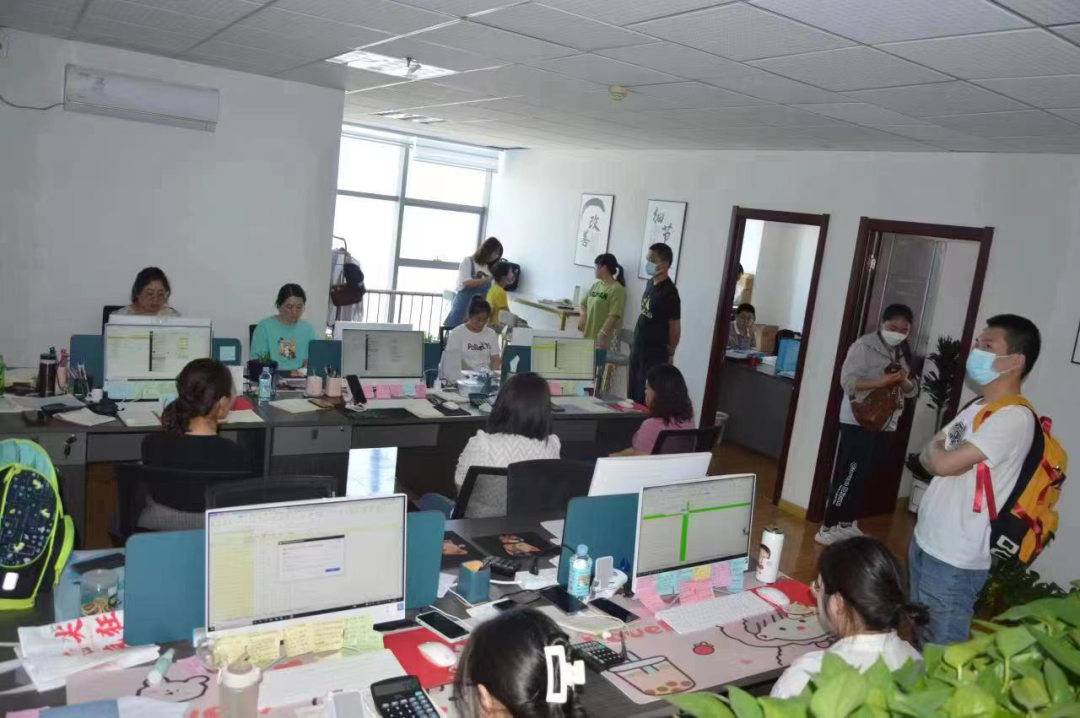Zhang Xin team of the Obstetrics and Gynecology Department of the Emergency General Hospital brings the gospel a good name for the severe anemia woman
Author:Emergency Hospital Time:2022.08.01
Recently, Ms. Wang came to the gynecological clinic of the Emergency General Hospital due to a large menstrual flow and a long bleeding time, and routinely checked the blood pigment 60g/L routinely. What does 60g/L mean? The hemoglobin of normal women is at least 115g/L. 60g/L's hemoglobin means that Ms. Wang's blood loss is as high as half of the normal women's blood cap Heart failure and coma have actually endangered the safety of patients.
After the emergency hospitalization, Director Zhang Xin of the obstetrics and gynecology department led the team to check Ms. Wang as soon as possible. The results show that its hemoglobin is only 56g/L, which is still declining compared with the previous. Through emergency blood transfusion treatment (4u in infusion of red blood cells), Ms. Wang's blood pigment was increased to 80g/L, which temporarily separated from the danger of life. What is the reason that causes Ms. Wang so low? After inspection and inquiring the medical history in detail, Ms. Wang has anemia since she was young, but has never been diagnosed by systematic diagnosis. In recent years, she has suffered from uterine myocularity in recent years. The size of the week), which leads to a large amount of menstrual flow, which is also the cause of severe anemia. Moreover, Ms. Wang has a long -term dysmenorrhea. Each menstrual period requires a one -time oral pain relief drug, and it takes multiple medicines to relieve pain a day. This seriously damages Ms. Wang's health.
How to completely solve a series of diseases that plague Ms. Wang, so that it is free from anemia, large menstrual flow, long menstrual time, and dysmenorrhea? Director Zhang Xin led the obstetrics and gynecologists to discuss and formulate a diagnosis and treatment plan for Ms. Wang. Given that Ms. Wang is nearly 50 years old and has no fertility needs, the doctor has developed three sets of diagnosis and treatment plans, namely GNRH-A drug treatment, promoting menstruation as soon as possible, GNRH-A treatment of 3-4 courses of treatment, uterine resection, direct uterus, direct uterus cut. If the first set of schemes are taken, the GnRH-A drug treatment can be taken. Although the uterus can be retained, it may still be possible to bleed more, the anemia continues to increase, and the possibility of recurrence after the drug is stopped; if the second set of schemes are taken, the Gnrh -A treatment of uterine resection after 3-4 treatments, the patient's treatment is not good, there are still many bleeding, anemia cannot be corrected, and the patient is out of visits due to fear of surgery. Director Zhang Xin believes that the third set is the best choice, that is, the uterine resection is performed directly after correcting the anemia. In view of Ms. Wang had a history of intestinal obstruction in 2017, the pelvic abdominal cavity is likely to have a large area of adhesion, which adds more uncertainty to the surgery. After careful preparation of the medical team, the surgery was performed as scheduled. Due to the long course of uterine adenocidal disease, the uterus was firmly sticking to the bottom of the pelvic cavity. Physician, carefully decompose the adhesion, and stabilize. Due to rich clinical experience, cooperating with tacit understanding, and fine operation, Ms. Wang's surgery is successfully completed. The cut uterus is like a small football. The thickened muscle wall also merged several uterine fibroids.
After the operation, Ms. Wang returned well. On the day of discharge, Ms. Wang saw "blood color" on her long -term anemia's face, showing her long -lost smile. After follow -up, Ms. Wang's hemoglobin has risen to 118g/L. She can finally get rid of the long -term "fatigue and weakness" and a few days of dysmenorrhea to torture. As soon as she met her neighbors and friends, she said excitedly: "The technology of the obstetrics and gynecology department of the Emergency General Hospital is really great. They have given me a new life!"
Science time
Uterine adenocular disease is an endometrium gland and interstitial invasion of the uterine muscle layer to form a pervasive or limited lesions. It is accompanied by compensatory hypertrophy and hyperplasia of the surrounding muscle layer cells. Film is caused by abnormal levels and belongs to a common disease of gynecology. Maternal maternal diseases over 40 years of adenomia disease are mainly manifested in the increase in menstrual volume and extension of menstruation, and gradually aggravating sexual dysmenorrhea. The uterus can even increase or have limited nodules to bulge, hard and tender, and tenderness is particularly significant during menstruation.
There are currently no effective drugs for root treatment. For those with lighter symptoms, non-steroidal anti-inflammatory drugs (ibuprofen, etc.), oral contraceptives (You Siyue, etc.) are treated symptomatically. For young, fertilized requirements, and recent menopausal patients, GNRH-A can be tried. -A can relieve or disappear and shrink the uterus, but the symptoms reclaimed after stopping the drug, and the uterine weight increased; The effect of relieving dysmenorrhea and reducing menstrual volume is exact, but it needs to be replaced after 5 years. Those with severe symptoms, age, non -fertility requirements, or invalid drug treatment can use general uterine resection. Therefore, the choice of clinical treatment plan needs to be individually selected in conjunction with the age, symptoms and fertility requirements of patients.
Introduction to Obstetrics and Gynecology

At the beginning of the establishment of the Emergency General Hospital (formerly Coal General Hospital), the Department of Obstetrics and Gynecology was established. There are currently 28 medical staff and 14 doctors, including 3 chief physicians, 5 deputy chief physicians, 4 attending physicians, residents Two people, including 3 doctoral students and 8 graduate students.
There are 21 beds in the department, and the ward and delivery room are redesigned and decorated, which is comfortable and quiet. At present, laparoscopic whole uterine resection, yin -type uterine division, laparoscopic auxiliary yin -type uterine division, uterine fibroid removal, attachment resection, ovarian cyst peeling, ovarian wedge resection, endometrium endometriosis Routine gynecological surgery such as septic removal, fallopian tube pregnancy lesions, fallopian tube umbrella ending, fallopian tubal reinforcement, pelvic adhesion and other conventional gynecological surgery; also conducts surgery and ovarian cancer surgery and ovarian cancer surgery and ovarian cancer surgery and ovarian cancer Chemotherapy. Various hysteroscopic surgery: diagnosis of uterine laparoscopic diagnosis of abnormal uterine hemorrhage, exotic, breeding ring residue/incarceration, endometrial polyps and submucosal fibroids of uterine mucosal fibroids. The department has a standardized maternal management system, and carries out eugenics, fetal custody, analgesic delivery, newborns bathing and touching, blue light radiation treatment, etc., so that the mother will give birth and childbirth in safety and comfort to ensure the safety of mothers and children's safety Like health.
Department of diagnosis and treatment characteristics:

Gynecological:
1. Ordinary gynecological: Frequently gynecological reproductive system inflammation, uterine fibroids, ovarian cysts, endometrial polyps, submucosal fibroids, reproductive system malformations and other diseases. Ordinary gynecological surgery is mainly minimally invasive surgery, especially good at uterine muscle muscle muscle muscles. Diagnosis and treatment of tumor and uterine adenoma.
2. Gynecological tumor: Gynecological malignant tumors such as cervical cancer, endometrial cancer, ovarian cancer can be accurately applied and comprehensive treatment.
3. Diagnosis and treatment of vaginal mirror and cervical cancer: scientific management of patients with HPV infection, through the screening of cervical cancer and vagoscopy, and implementing standard treatments such as LeEP or cervical cold knife cone in patients with cervical lesions. Cervical cancer early detection, early diagnosis, and early treatment.
4. Gynecological endocrine: Anechetic clinic for menopausal clinics, for patients such as menstrual abnormalities, premature ovarian failure, abnormal reproductive function, and perimal period diseases, formulate a reasonable and effective treatment plan to improve the living standards of patients.
5. Pot bottom dysfunctional diseases: diagnosis and treatment of postpartum pelvic floor relaxation, uterine prolapse, vaginal wall swelling, stress urinary incontinence, various genital tract fistula, cesarean section scar diverticulum, vaginal relaxation, labia abnormal diagnosis and treatment have the diagnosis and treatment. Rich clinical experience.
family planning:

Carry out early pregnancy, painless abortion, visual flow, medium -term pregnancy induction of labor, upper ring, ring, sterilization, etc.; laparoscopic falloposcopy, fallopian tubal reinstation, and fallopian tubes are carried out to relieve trouble for infertile patients.
obstetrics:

1. Pre -pregnancy health care and pre -pregnancy consultation.
2. Conventional prenatal examination and health care; have rich experience in the treatment of normal delivery, dystocia, pregnancy complications, pregnancy complications, and complications during childbirth.
Our obstetrics outpatient clinics: Outpatary of obstetric nutrition management, outpatient medical clinic, prenatal consultation clinic.
3. Postpartum rehabilitation: Rehabilitation treatment of breast dredging, uterine recovery, rectus abdominis, and back pain after giving birth, and postpartum back pain during postpartum hospitalization. Patients with dysfunction of pelvic foundation after discharge can be treated with pelvic floor rehabilitation.
Leader of Obstetrics and Gynecology
Zhang Xin, chief physician, well -known expert, director of the obstetrics and gynecology department and outpatient department of the Emergency General Hospital.

Good at: diagnosis and treatment of various gynecological and malignant tumors; diagnosis and treatment of HPV infection and diagnosis of cervical cervical cervical cervical cancer; perinatal management of high -risk pregnant women.
Graduated from the Chinese Academy of Medical Sciences China Concorde and Medical University, has been engaged in clinical work of obstetrics and obstetrics, and has rich clinical experience and solid professional knowledge of obstetrics and gynecology. Proficient in all levels of gynecological and obstetrics at all levels, especially good at the diagnosis and treatment of various gynecological and malignant tumors, and the perinatal management of high -risk pregnant women. The "escort" of the whole process and safety of the pregnant women's pregnancy and normal childbirth can be used to be proficient in treatment of high -risk pregnant women such as dystocia, gestational diabetes, pregnancy hypertrophy, and postpartum bleeding. The diagnosis and treatment of endometriosis, endometrium cancer, cervical cancer and ovarian cancer have unique insights. In recent years, the main attack of HPV infection and diagnosis of cervical cancer lesions.
In 2013, he went to the East District Hospital of Hong Kong to be a visiting scholar to learn about the international forefront of obstetrics and gynecology and advanced doctor -patient concepts. He published more than 30 papers in professional journals at home and abroad, participated in three editors, and completed five scientific research. One of them was funded by the National Natural Science Foundation of China. He is currently serving as a member of the Military and Child Wealth Commission of the China Maternal and Child Health Association; the Member of the Gynecological Pot File of the Obstetrics and Gynecology Branch of the China Medical Care International Exchange Promotion Association; Member of the Expert Committee of the Obstetrics and Gynecology Database of Clinical Diagnosis and Treatment; experts from the medical accident appraisal committee of Chaoyang District, Beijing; and magazine review experts such as "China Medical Science" and "Clinical Medicine Progress".
Democratic time: Tuesday afternoon, Friday morning
Planning: Rong Media Center
Source: obstetrics and gynecology
Author: Zhang Siyi
Review: Zhang Xin
Produced: Peng Xuezheng
Edit: Mo Peng
- END -
When the suspect was arrested, the balance of the card was more than 40 million yuan!

If it wasn't for the police to solve the case, Master Chen would not believe that ...
Sohu famous doctor | Yu Kang: About 300 million people in our country have "hidden hunger"

Produced | Sohu HealthAuthor | Zhou YichuanEdit | Yuan YueIn recent years, the hea...